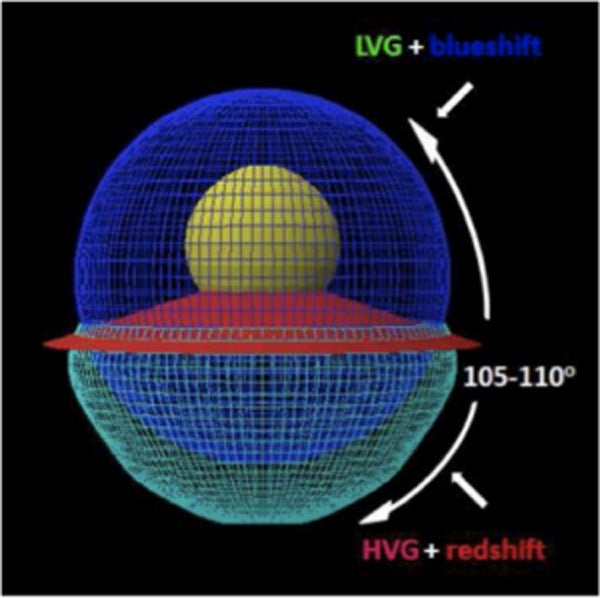An international collaboration of researchers led by Keiichi Maeda from the Institute for the Physics and Mathematics of the Universe (IPMU) at the University of Tokyo has solved a mystery regarding type Ia supernovae. Type Ia supernovae form a homogeneous class of stellar explosions and are used as “standard candles” to study the acceleration of the universe. However, it has long been known that type Ia supernovae that otherwise look like twins can show diverse spectral features, questioning their accuracy as standard candles.
The research group argues that type Ia supernovae explode asymmetrically, and that the different spectral appearance is merely a consequence of the random directions from which a supernova is observed. This result is good news for cosmology because it suggests that the spectral diversity is no longer a major concern in using type Ia supernovae as cosmological standard candles.
Type Ia supernovae have been playing a key role in cosmology and in the discovery of dark energy since they can be used to measure distances across the universe. This relies on the well-developed relation between their brightness and the decline rates — brighter supernovae decline slower.
This single parameter description of type Ia supernovae may well reflect the uniform nature of the progenitor system. Type Ia supernovae are explosions of a white dwarf consisting of carbon and oxygen. The explosion is triggered by sparks of thermonuclear flames ignited in the innermost part of the white dwarf, although how the explosion is initiated is still in debate. The explosion most likely takes place when the white dwarf reaches the Chandrasekhar mass (about 1.4 times the Sun) through accreting materials from its binary companion or by merging with another white dwarf.
However, recent investigations have revealed that the true nature of type Ia supernovae is far more complicated. They indeed do not look like a uniform system in their spectral features. Type Ia supernovae that look like twins concerning their luminosity evolution can demonstrate quite different behavior in the speed with which their spectral features evolve — the velocity gradient. Scientists first noticed this spectral evolution diversity in the late 1980s, and they quantified it beyond doubt in 2005. The origin of this diversity has not been clarified, raising a couple of concerns: Are they really good standard candles? Are they from a uniform progenitor system?
The research group led by Maeda, including Ken’ichi Nomoto and Masaomi Tanaka of IPMU, has reported that it has finally identified the origin of the diversity. The members found that the velocity gradient is closely related to another independent observed quantity, namely the wavelength shift of emission lines in late-time spectra of type Ia supernovae taken about 200 days after the explosion. This late-time emission-line shift has a straightforward interpretation that the shift can arise only if the innermost part of the supernova is asymmetric, and the degree of the shift depends on the direction from which the supernova is observed. Now the origin of the spectral evolution diversity must be the same; it is merely a consequence of the random directions from which a supernova is viewed.
“This is a single stone to kill at least three birds,” said Maeda. “It is not only about uncovering the origin of the spectral diversity. The finding now gets rid of a concern about using type Ia supernovae for cosmology since this viewing angle effect will average out if we collect many supernovae. In addition, the idea of the uniform progenitor system is rescued. Finally, this is the first strong observational indication about how the thermonuclear flames are ignited in the explosion. The finding points to asymmetric, off-center explosions, as opposed to what most people had believed so far.”
“It was amazing to see that the mystery of the supernova spectral diversity was immediately solved when we found this new correlation,” said Stefano Benetti from Osservatorio Astronomico di Padova, Italy, who in 2005 pointed out the problem that the spectral diversity is not correlated with the supernovae luminosities. “I first ran into this mystery already in 1989 while working on my master’s thesis.”
“This is a major step forward in the supernovae cosmology,” said Maeda. “We have obtained the good insight into properties of type Ia supernovae, which is necessary if we are to aim at the more accurate cosmological measurements.”










